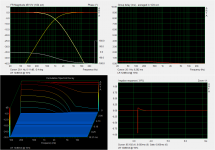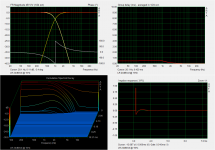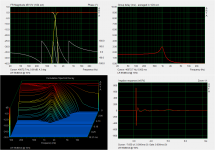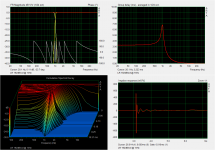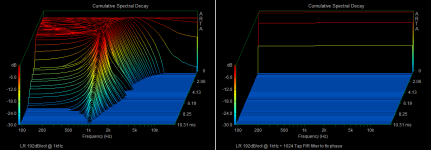@bentoronto,
+1 that having a DSP in your arsenal of audio tools is of great benefit for research and design.
Looking at your frequency response plots, it is clear that you aren’t necessarily just evaluating XO slope changes, but also frequency response changes. From your research background you should appreciate the concept of only changing one variable at a time so as to improve cause/effect correlation.
For XO slope investigation, you need to first use your DSP to EQ the LF and HF drivers to a flat response at least an octave past the crossover point (with room effects windowed out) and adjust delay for one of the drivers to match phase with the other driver thru the crossover range. Then you will find the response at your listening seat changes very little as you roll thru increasing crossover slopes. Your comments about needing to use a driver within its “happy” range is well taken, and that “happy” range can often be extended when sharper XO slopes are used.
As mentioned by CharlieLaub and Davey (also alluded to by AllenB), one of the downsides of increasing XO slope is increased delay and ringing around the XO frequency. Last year I went thru a similar exercise for XO @ 1kHz, 1.5kHz, and 2kHz with slopes 12dB/Oct thru 192dB/Oct using a miniDSP HD which also allowed me to remove the ringing and delay using its FIR filter capability. Attached are measurements of the 1kHz filtering of the line level signal feeding the LF and HF amplifiers. Acoustic measurement at the listening position was essentially unchanged. The last attachment shows the CSD plot for the 192dB/Oct with the FIR filter to linearize phase toggled on/off…just a verification that it was indeed doing what it was supposed to do.
Results? Nothing earth shattering. The often recommended 24dB/Oct does seem to be the sweet spot for simplicity vs results with passive crossovers. With DSP, I’d say 48dB/Oct might be it for IIR filters. By 96dB/Oct some of the effects of the delay/ringing started to show up, with no other apparent improvement to warrant the steeper slope. It was interesting to listen to the 192dB/Oct with its huge delay and ringing. On some music it wasn’t really noticeable even when toggling the FIR filter on/off. Not surprisingly, percussive piano playing seemed to highlight it. Of course I only have one pair of ears/brain.
+1 that having a DSP in your arsenal of audio tools is of great benefit for research and design.
Looking at your frequency response plots, it is clear that you aren’t necessarily just evaluating XO slope changes, but also frequency response changes. From your research background you should appreciate the concept of only changing one variable at a time so as to improve cause/effect correlation.
For XO slope investigation, you need to first use your DSP to EQ the LF and HF drivers to a flat response at least an octave past the crossover point (with room effects windowed out) and adjust delay for one of the drivers to match phase with the other driver thru the crossover range. Then you will find the response at your listening seat changes very little as you roll thru increasing crossover slopes. Your comments about needing to use a driver within its “happy” range is well taken, and that “happy” range can often be extended when sharper XO slopes are used.
As mentioned by CharlieLaub and Davey (also alluded to by AllenB), one of the downsides of increasing XO slope is increased delay and ringing around the XO frequency. Last year I went thru a similar exercise for XO @ 1kHz, 1.5kHz, and 2kHz with slopes 12dB/Oct thru 192dB/Oct using a miniDSP HD which also allowed me to remove the ringing and delay using its FIR filter capability. Attached are measurements of the 1kHz filtering of the line level signal feeding the LF and HF amplifiers. Acoustic measurement at the listening position was essentially unchanged. The last attachment shows the CSD plot for the 192dB/Oct with the FIR filter to linearize phase toggled on/off…just a verification that it was indeed doing what it was supposed to do.
Results? Nothing earth shattering. The often recommended 24dB/Oct does seem to be the sweet spot for simplicity vs results with passive crossovers. With DSP, I’d say 48dB/Oct might be it for IIR filters. By 96dB/Oct some of the effects of the delay/ringing started to show up, with no other apparent improvement to warrant the steeper slope. It was interesting to listen to the 192dB/Oct with its huge delay and ringing. On some music it wasn’t really noticeable even when toggling the FIR filter on/off. Not surprisingly, percussive piano playing seemed to highlight it. Of course I only have one pair of ears/brain.
Attachments
@Bolserst You have touched on one of the big potential drawbacks of DSP in that allows you do whatever you want, rather than what you should do. Makes it much easier to get it wrong if you don't think it through and just chuck processing at the problem.
Interesting plots. Thank you for sharing them.
Interesting plots. Thank you for sharing them.
“Just because one can, doesn’t mean one should”
As in all things in life��
As in all things in life��
Last edited:
@billshurv
This is not a fault of the DSP, it only does what it is instructed to do.
Never said it was and not sure how you inferred that.
Well, you said it was a drawback of DSP! Don't know if it is my lack of English skills, but...
For me personally, DSP have made me make leaps in understanding of loudspeakers and room interacting...
Each to their own🙂
For me personally, DSP have made me make leaps in understanding of loudspeakers and room interacting...
Each to their own🙂
He meant "drawback" in the sense that allows folks to screw with things endlessly.
In that sense you can lose sight of the starting line and the finishing line of what you're trying to achieve, practically.
This is the classic example of a slippery slope......audiophile-wise.
Dave.
In that sense you can lose sight of the starting line and the finishing line of what you're trying to achieve, practically.
This is the classic example of a slippery slope......audiophile-wise.
Dave.
... For me personally, DSP have made me make leaps in understanding of loudspeakers and room interacting...
+1
Haven't yet digested Bolserst always insightful post with the great data. But I do notice the thread has turned into vindictive DSP-bashing and DSP-defence.
I notice that Bolserst suggested the sweet-spot seems to at 48dB/8ave. That's DSP territory isn't it?
Also, Bolserst is the first to mention the improvement in post #1 may have to do with the FR of the drivers an octave beyond XO freq. Another way to say that is, shallow slopes can crap up your sound by letting wider, perhaps badly EQ'ed bands into the mix and/or obliging the drivers to play outside their happy band. The crap is blocked by using steep slopes. Likewise, it really has helped me to be able to focus just on a narrow XO band. (BTW, going to 48dB will make decisions about polarity of drivers clearer.)
A final thought: "ringing" sounds just terrible... but is it? Is "ringing" one of those parameters you hear with your eyes when looking at plots (such as that phantom problem of phase) or is it actually something audible (like FR)? And if audible, are we talking about 200dB slope, as Bolserst mentions or 48?
B.
Last edited:
DSP territory? No, analog filters/crossovers can easily be created with 48db/octave slopes.
And, the LR48 implementation was pondered upon by Linkwitz (and others) way back in the late 70's. In that context, the audibility of the increased group-delay was the trade-off primarily considered. A trade-off which still exists today BTW. Unless, of course, you implement with FIR-based filtering. But, then you have other trade-offs. 🙂
Active Filters
"DSP-bashing and DSP-defence"? 🙂 I think you might be projecting, just a touch.
Dave.
And, the LR48 implementation was pondered upon by Linkwitz (and others) way back in the late 70's. In that context, the audibility of the increased group-delay was the trade-off primarily considered. A trade-off which still exists today BTW. Unless, of course, you implement with FIR-based filtering. But, then you have other trade-offs. 🙂
Active Filters
"DSP-bashing and DSP-defence"? 🙂 I think you might be projecting, just a touch.
Dave.
I'm talking about active, line-level filters, obviously. 🙂
Copper and foil caps not required.
Dave.
Copper and foil caps not required.
Dave.
Not sure how you configured your system but I interact with nothing more than the front of my receiver when I listen to my tri-amped living room system or my biamped mixing room system. Now I leave my components on 24/7 unless I'm away so there are certainly a few more on/off switches involved in shutting it all down but there is nothing complicated about running a DSP crossover based audio system in daily operation. It's all in the configuration.
Ben,
...
It's very difficult to get a multi-amped DSP-based system to be this easy to use. It's much easier to design & implement a decent passive crossover, so that's the route I took.
Chris
Just two power switches here to flip, wait for things to warm up (there are tubes involved) then select source, unmute and turn up volume.
Some, not all sources need to be turned on - digital is via always on streaming hardware.
Six amplifiers, two 3-way LR4 XO, DSP, line stage and sources. Set up is a bear, but once sorted out pretty easy to use.
Average week usage is > 30 hours.
Some, not all sources need to be turned on - digital is via always on streaming hardware.
Six amplifiers, two 3-way LR4 XO, DSP, line stage and sources. Set up is a bear, but once sorted out pretty easy to use.
Average week usage is > 30 hours.
I love it when one side of an argument can convincingly back their claims and the other side can convincingly counter-claim. Dogs and cats unite!
I don't necessarily have a horse in this race, but instinctively "know" that you can't polish a turd with math.
Attempt to get the natural baseline behavior correct before employing the magic wand.
I don't necessarily have a horse in this race, but instinctively "know" that you can't polish a turd with math.
Attempt to get the natural baseline behavior correct before employing the magic wand.
I think that for tests/comparisons/etc...., a processor like QSC QSys or Xilica Solaro are much more powerfull than old and very limited Behringers : you can instantaneously switch (not 3s !) and directly compare FIR to IIR, switch slopes and or frequencies, delays, room correction, etc...With a DSP, takes about 20 seconds to switch from one slope to the other. Or to change the XO frequency a bit. Or to..... And it takes just 3 seconds to replace the old setting memory with the new settings (Behringer DCX2496).....I just can't understand how a DIY person can be without DSP, even if just for setting up their HiFi.
Those processors have a completely configurable schematics and adjustments/switches with a remote controller (tablet, phone or PC) are so smooth.
I love it when one side of an argument can convincingly back their claims and the other side can convincingly counter-claim. Dogs and cats unite!
I don't necessarily have a horse in this race, but instinctively "know" that you can't polish a turd with math.
Attempt to get the natural baseline behavior correct before employing the magic wand.
It's probably best not to crave for actual facts. 🙂
Does depend what needs polishing surely?I don't necessarily have a horse in this race, but instinctively "know" that you can't polish a turd with math. [
Can you explain more what you mean? This statement could be interpreted a number of ways and don't want to get the wrong end of the stick before agreeing with you.Attempt to get the natural baseline behavior correct before employing the magic wand.
- Home
- Loudspeakers
- Multi-Way
- XO slope and why you need DSP
